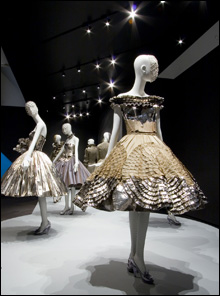
VIKTOR & ROLF: Today Newbury Street, tomorrow — well, Sunday — the MFA.
|
I feared for my life when I walked into the Downtown Crossing H&M one morning last November. Stella McCartney’s H&M line was being unveiled, and women were tearing pants and ruffled tops from racks as though the fate of their immortal souls depended on it. On a regular Saturday, H&M is a delicious vortex capable of sucking you in for an entire afternoon as you riffle through piles of trendy clothes whose edge has been dumbed down in order to accommodate the critical shopper with a limited budget who wants to be sharply dressed without being shocking. The music is always too loud, the lines for the dressing rooms are laughably long, and the notion of finding a shirt in a size other than the one you saw flung on the floor is a ridiculous pursuit that ends only in heartache. But on Stella McCartney Day, nobody was safe at H&M.
Driving shoppers in was the knowledge that, with 50 bucks and a quick hand, you could walk out with a piece designed by a woman who sells similar items for thousands at her own store. This was a limited-edition run, and most of Stella’s line sold out in a matter of hours; just a few random scarves were left swinging eerily in the void. There was screaming; there was grabbing; there were energetic battles over mannequins of samples. It was the urban chain-store equivalent of a war zone, with such spoils as a pair of inexpensive well-cut skinny jeans. Was it worth it? I’m certain anyone who left with authentic Stella cargo priced for the masses would sigh, smile, and happily answer yes, even as she bandaged up the scratches on her arms and wondered when she’d be able to wear that super-tight pencil skirt.
The Swedish retailer represents what many in the industry consider the ultimate source for democratic high fashion. The Museum of Fine Arts’ latest blockbuster, “Fashion Show: Paris Collections 2006,” takes its cue from the H&M philosophy. In a vein similar to the other textile exhibitions of its caliber — recently the Victoria & Albert Museum’s “Sixties Fashion” and MOMA’s “AngloMania: Tradition and Transgression in British Fashion” — “Fashion Show” sets out to prove that it’s possible to strip away the mystique associated with the insular world of haute couture and spin it into a specialized art form.
Timed in conjunction (November 18–March 25) with a “Fashion Photography” exhibit that presents prints by the likes of Cecil Beaton and images of Greta Garbo and Twiggy, “Fashion Show” was, it’s clear, not shaped to mimic the intimidating elitism associated with, say, the Louis Vuitton flagship store on the Champs-Élysées. There’s none of the sweaty trauma of a Project Runway challenge — which these days is probably as tense as an atelier’s inspection by the Chambre Syndicale de la Haute Couture. Rather, “Fashion Show” inspires the same accessible, energized sense rush of satisfaction that comes from happening on a Filene’s Basement treasure for a fraction of the original price, or a Behnaz Sarafpour top from Target’s discount-designer Go International series. Minus the hair ripping and teeth gnashing, of course.
In displaying 10 full looks by 10 designers — a mix of French-born and foreign, couture and ready-to-wear — “Fashion Show” deals in restraint when it could have saturated, with a layout that resembles a sequence of store windows instead of an installation. And yet, how often do you go to Paris to gape at a Karl Lagerfeld suit that took 780 hours to embroider? Short of jumping into one of his tailored Chanel outfits and pulling on a pair of his two-toned lambskin boots, it’s unlikely that the experience could get much more personal than this.
If you’ve ever watched a couture runway show on the Style network or heard supermodel Tyra Banks bellowing at her charges on America’s
Next Top Model about the importance about being able to wear couture properly, then you know that couture fashions aren’t conventionally appealing. The pieces are about the finishing, the detailing, the embellishment, and the balls-out glamor. And though no contemporary high-fashion designer would state that his or her work can be appreciated only by the wealthy and the beautiful, there’s always been a disappointing gap between the idea and the execution of egalitarian couture.
But the fashion world is experiencing something of a cultural revolution of late, thanks to the success of Bravo’s Project Runway and its behind-the-scenes glimpse into garment and runway production, not to mention the cult-of-personality crossover between celebrity image and design talent. Mary-Kate and Ashley Olsen have had a kids’ line since they were kids, and Jennifer Lopez, P. Diddy, Gwen Stefani, Jessica Simpson, Justin Timberlake — the list goes on — have followed, clamoring for a chance to force-feed their fashion sense on Macy’s junior departments and the general public. Two of the designers chosen to be in “Fashion Show” on the strength of their influence have also signed contracts with H&M. The first to do so was Lagerfeld, who became the head designer for Chanel after Coco’s death in 1971; the latest line, which is available in H&M stores today (November 9), was created by the Dutch team Viktor & Rolf. The most extensive of the guest collections thus far, it includes everything from a pair of high-heeled shoes to a $349 demurely ruffled wedding gown.